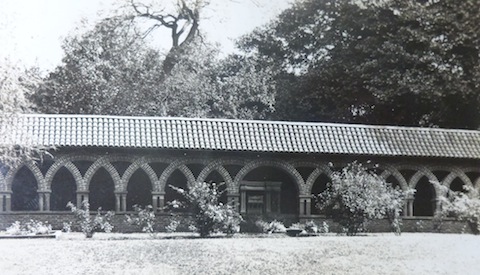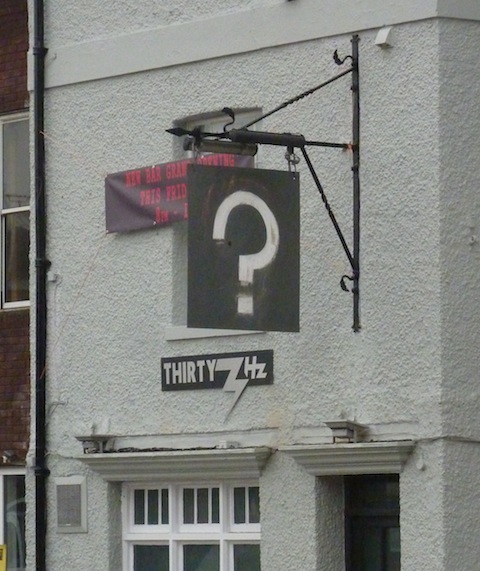 Abraham Lincoln
If given the truth, the people can be depended upon to meet any national crisis...
Abraham Lincoln
If given the truth, the people can be depended upon to meet any national crisis...
 Guildford news...
for Guildford people, brought to you by Guildford reporters - Guildford's own news service
Guildford news...
for Guildford people, brought to you by Guildford reporters - Guildford's own news service
Where Is This? No.106
Published on: 22 Apr, 2014
Updated on: 22 Apr, 2014
By David Rose
Many thanks to all who replied last week. The vintage picture did indeed show the Little White Lion pub and Woolworths in North Street.
The Vintners Arms, as suggested by Shirley West, was a little further up the street, probably where a new coffee shop is now.
The quirky photo showed a plaque on the wall of Holy Trinity Church in the High Street.
Once again, click here to see the post and all the replies at the foot of it. Chris Townsend gives some extra details and Ray Springer points readers to Holy Trinity Church’s website where there is lots more information.
Interesting and not surprising really the comments about Wollies. A fondly remembered store. Yes, you could buy just about anything there. The only slightly funny story I have about the cafe is from a friend who had a summer job there before he went to university. I recall at the time (about 1975) him telling me all hell broke loose the day when the asparagus soup and the custard were served as one another!
In his comment, Brian Holt reminds us that Woolworth’s off licence was at the North Street end. If you want to see what ‘Guildford Anoraks’ like him also get up to, click on Guildford City FC’s latest match report on the Dragon. Scroll down to the photo that’s at the foot of the post and you’ll see Brian second from the left. His brother George is pictured far left.
Let’s move on to this week’s pair of images.
The vintage photo was taken probably not long after this structure was built. It’s somewhere to the south west (roughly) of Guildford. The association is a Victorian artist and there was once a pottery nearby.
The quirky photo is of a new sign on a bar that has had many a name change in recent years, although its original pub name with an agriculture connection lasted for decades.
I have worked out what Thirty 3 Hz stands for! Say no more at the moment.
If you think you know the answers, and may be able to add some extra details, please leave a reply in the box below. The answers, along with the next pair of images, will be published about the same time next week.
Responses to Where Is This? No.106
Leave a Comment Cancel replyPlease see our comments policy. All comments are moderated and may take time to appear.
Recent Articles
- Guildford Institute’s Crowdfunding Project for Accessible Toilet in its New Community and Wellbeing Centre
- Letter: Guildford – Another Opportunity Missed?
- Letter: GBC’s Corporate Strategy – Where Is the Ambition?
- My Memories of John Mayall at a Ground-breaking Gig in Guildford Nearly Six Decades Ago
- Westborough HMO Plans ‘Losing the Heart of the Street’ Says Resident
- College Invests to Boost Surrey’s Economy and Close Digital Skills Gap
- Community Lottery Brings Big Wins for Local Charities
- GBC Housing Plan Promises ‘A Vibrant Urban Neighbourhood’ Near Town Centre
- Hospital Pillows ‘Shortage’ at the Royal Surrey
- Updated: Caravans Set Up Camp at Ash Manor School


Recent Comments
- Ian Macpherson on Updated: Main Guildford to Godalming Road Closed Until August 1
- Sara Tokunaga on GBC Housing Plan Promises ‘A Vibrant Urban Neighbourhood’ Near Town Centre
- Michael Courtnage on Daily Mail Online Reports Guildford Has Highest-paid Council Officer
- Alan Judge on GBC Housing Plan Promises ‘A Vibrant Urban Neighbourhood’ Near Town Centre
- John Perkins on GBC Housing Plan Promises ‘A Vibrant Urban Neighbourhood’ Near Town Centre
- S Collins on GBC Housing Plan Promises ‘A Vibrant Urban Neighbourhood’ Near Town Centre
Search in Site
Media Gallery
Dragon Interview: Local Artist Leaves Her Mark At One of England’s Most Historic Buildings
January 21, 2023 / No Comment / Read MoreDragon Interview: Lib Dem Planning Chair: ‘Current Policy Doesn’t Work for Local People’
January 19, 2023 / No Comment / Read MoreA3 Tunnel in Guildford ‘Necessary’ for New Homes, Says Guildford’s MP
January 10, 2023 / No Comment / Read More‘Madness’ for London Road Scheme to Go Ahead Against ‘Huge Opposition’, Says SCC Leader
January 6, 2023 / No Comment / Read MoreCouncillor’s Son Starts Campaign for More Consultation on North Street Plan
December 30, 2022 / No Comment / Read MoreCounty Council Climbs Down Over London Road Works – Further ‘Engagement’ Period Announced
December 14, 2022 / No Comment / Read MoreDragon Interview: GBC Reaction to the Government’s Expected Decision to Relax Housing Targets
December 7, 2022 / No Comment / Read MoreHow Can Our Town Centre Businesses Recover? Watch the Shop Front Debate
May 18, 2020 / No Comment / Read More











Bernard Parke
April 23, 2014 at 2:37 am
1) Watts Gallery
2) The pub which was recently platform 9
The inscription is refers to the third name of the pub which was the subject of a competition to name it.
John Lomas
April 23, 2014 at 9:44 am
This is the Watts Gallery at Compton, the cloistered walkway seen in the photo appears from their Website to be now enclosed entirely within the building so unless they moved the arches I am guessing they have built out over the area wher the bushes are.
The nightclub is on Park Street, formerly Platform Nine and previously the Plough. If that is the one I think it is they used to have barrels laid on their sides in the backroom and glasses were filled direct from the barrel taps rather than drawn through pipes by beer engines, this was a late as around 1980.
The Thirty 3Hz could be a reference to a band from New York or it might be refering to the effect that that frequency is alledged to have on parts of some people’s anatomy.
Josef
April 23, 2014 at 11:18 am
The first one is next to the Church of St Peter and St Paul in Godalming. The second one is the Thirty 3 Hz bar (as mentioned) next to the underpass from the George Abbot pub car park, next door to the Guildford Charcoal Grill. It was previously called Platform 9, and possibly Diva.
Mike Bailey
April 23, 2014 at 5:24 pm
The first time I have had the answer!
Thirty 3Hz is on Park Street next to the kebab shop, recently opened. No idea on the meaning behind the name though.
A guess on the first one, based on the clues, would be Smithbrook Kilns but I am just guessing there.
Shirley Graber
April 24, 2014 at 10:35 pm
The sign is on the pub in Park Street most recently known as Platform 9.
I’m not sure about the vintage photo but may be connected with Watts, perhaps his home Limnerslease?
Fiona Curtis
April 25, 2014 at 12:28 pm
The Cloisters at Watts Cemetery in Compton. I have never seen this photograph, so many thanks. The Cloisters lies within the grounds of Watts Cemetery and is where George Frederic Watts (renowned victorian artist) is laid to rest with his wife Mary, who designed the Chapel (in the grounds). The cloisters are influenced by Italian architecture and in 2013 the Huxley Society donated a lovely bench which sits in the cloisters, in memory of Aldous Huxley, who is also buried at the Cemetery. The ornate iron gates were made by local blacksmith, Clarence Sex (who also constructed the ironwork for the Chapel doors). The previous blacksmiths in Compton (and Puttenham) were the Hookers!
Chris Townsend
April 27, 2014 at 6:15 pm
The Grade II listed Italianate cloister is in Compton Cemetery, on Budburrow Hill. It was designed by Mary Watts, widow of George Frederick Watts, as a memorial to him. Both are buried near the entrance arch in the centre of the photo. The cemetery, its chapel and memorials are well worth a visit, or watch a video here:
http://www.wattsgallery.org.uk/watts-chapel
The quirky photo is of the “brand new, elegant nightspot in the heart of Guildford town center” at 16 Park Street that was once The Plough, built about 1850.
Ray Springer
April 28, 2014 at 3:57 pm
I think this must be Watts Gallery at Compton, although I have never been there. The clues you give relate to George Frederick Watts, and a pottery at Compton.
The pub (what a strange name for a pub) was once and will always be known as the Plough.
It has been called Scrumptious and Platform Nine in the past.
Brian Holt
April 28, 2014 at 10:55 pm
First photo is Guildford Crematorium.
Second photo: this was the old the Plough Inn on Park Street, which was set up by Thomas White, a brewer, in 1846, soon after the building of the railway station at the end of the street.
The building itself dates from 1810. Friary Holroyd & Healy’s brewery took it over in 1890 and Edwin Moss was the landlord from 1895 until the outbreak of the First World War.
The landlord use to have a lamp above the door with his name on it.
Now it is the new bar Thirty 3 HZ.
Doug and Bill Stanniforth
April 29, 2014 at 4:42 pm
The first photo is of Watts Gallery.
The quirky photo is in Park Street and was the Plough. The 33 Hz is a famous radio frequency, probably used by speedboat enthusiasts.
Jonny outram
May 12, 2014 at 3:11 am
Hi everyone! I’m the new owner of the new bar in Guildford! It is no longer a pub and not just another re naming of a dilapidated venue.
I own the freehold of the property and have completely gutted the building. When I arrived, plants were actually growing through the walls!
As for the naming… I ran the competition because I found the idea of choosing a name so daunting. I’m sure Some people will love the name and some will hate it but my feeling is that eventually when people say “Thirty3Hz” they will not try and think of the meaning but immediately just relate the name to the bar.
Please check out the web page. http://Www.Thirty3Hz.com
I’m aiming for a classy, exclusive venue.
Feel free to come in for a cocktail or two..
C Neville
May 14, 2014 at 10:22 pm
The first is just above the beautiful chapel that Mrs Watts had built with the local children painting some of the amazing tiles on the walls. I recently took a friend to see this Pre Raphaelite chapel and as she walked through the doorway I could hear her gasp of amazement as it is so beautiful- a gem all should see. Just above the chapel higher up the graveyard is this colonnade and in front of it in the middle are the graves of George Watts, his wife and their daughter.
The second is a building in Park Street that was boarded up for several years and had pigeons always resting on the roof and plants growing out of the walls down the drainpipe. Very sad to see buildings left like this. I thought the original building was older than the 1800s though. I thought some of its origins were Medieval? Pebbledash never helps, but there are some good photos to be found of buildings in Park Street which are certainly older than 1800s.